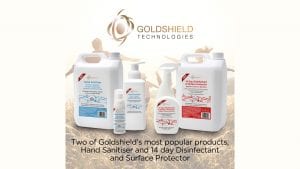
Goldshield’s innovation could help combat the global issue of healthcare-associated infection, including COVID-19.
Goldshield Technologies was founded in 2008 by Tom Higgins, an expert in textiles with extensive experience in the industry. Higgins had developed a unique organosilane-based antimicrobial chemistry and founded the company to commercialise this technology. Unlike other organosilane-based technologies, the formulation is water-stable.
Prior to the invention, Higgins was looking for antimicrobial technologies for the textile industry, particularly technologies that can prevent odour-causing bacteria and fungi. After several years of research, during which his father passed away from a hospital-acquired infection (HAI), Higgins refocused his energy on a new aim: developing technologies to mitigate HAIs caused by contaminated textiles and surfaces. Healthcare-associated infections kill over 240 people every day in the USA, with unrecoverable costs estimated to be $80bn per year.
With the help of a former Dean of Harvard Medical School and another Harvard medical doctor, Goldshield Technologies conducted early stage research to determine parameters such as which surfaces can be coated with antimicrobial technologies, how often they can be coated, how they can be coated, and the impact of each surface. Goldshield then sought independent validation of its technology in clinical trials at hospitals. The results of the trials have been peer reviewed and published in the prestigious American Journal of Infection Control. Such information is crucial for companies and technologies to be marketed into the healthcare industry.
Technology
Goldshield has developed a water-based organosilane technology with surface penetrating compounds. The active compound consists of a silane base and a quaternary ammonium compound.
Through the inclusion of three hydroxyl groups into the organosilane, Goldshield has converted the organosilane from hydrophobic to hydrophilic. The polyol enables a stable water-based system that does not result in self-condensation of the organosilane.
Goldshield’s formulation does not include acids, solvents, and is not inflammable. Goldshield’s formulation can be easily applied via a regular spray bottle. It can also be applied via electrostatic spraying, where a single gallon can cover 5,000 square feet; but outside of efficiency, electrostatic spraying is not necessary for application.
Additionally, the formulation includes a surface-penetrating compound which breaks down the interfacial tension of the surface. The concentration of this component is kept between nine and 11 moles to retain the right pH of the solution. If it is too acidic or too alkaline the silane moieties cannot bond to the surface. At the right concentration, the component allows the silane moiety to form nonpolar covalent bonds with the substrate to be coated. Once this bond is formed, the antimicrobial coating does not become ‘fugitive’ and adheres to the surface. The positive charge of the quaternary ammonium compound draws bacteria to the substrate.
The last component, a long carbon chain, disrupts bacterial cell walls and other microbial membranes through lysis. This is the longest lasting component in Goldshield’s formulation and is active for a minimum of 90 days; however, the overall product is not always marketed for 90-day application cycles. For example, places which experience a high bioburden, such as hospitals, would be advised to re-apply Goldshield every 30 days.
Goldshield’s antimicrobial technology has been proven in three clinical trials which have been published in the American Journal of Infection Control. Among these trials is a nine-month study where Goldshield’s coating was applied to five high-touch points in 18 intensive care units. Through investigating over 60,000 cultures, it was determined that Goldshield could reduce bioburden by three to four log. Goldshield has run the only study that shows a direct correlation between the use of chemistry on surfaces with reductions in healthcare associated infections. Goldshield coatings have been used in research by the California Institute of Technology at the Jet Propulsion Laboratory/NASA and has shown a 100% biofilm prevention on materials that are used on the International Space Station.
Additionally Goldshield is working with a global petrochemical company on a prospective plan to roll out its protective products to be used in petrol stations starting with the UK, Europe and the US.
Goldshield has been investigating the application of its technology to personal protective equipment (PPE). Microorganisms are able to survive for long periods on textiles – for example, SARS-CoV-2 is known to survive on face masks for up to seven days – and so Goldshield worked with one of its partners in China to test the ability of Goldshield-coated face masks to kill SARS-CoV-2. The study showed that face masks covered with Goldshield were able to deactivate 2.92 log of the virus vs the control group, equivalent to an inactivation rate of 99.88%. Furthermore, the masks showed residual antiviral activity for up to three days.
A previous study from 2015 further indicates that Goldshield-coated face masks can remove 99.3% of bacteria. Goldshield will be continuing its research on application to other forms of PPE, with the goal of up to seven logs reduction: this will close the infection control gap and allow PPE to work effectively in protecting wearers and those around them. Otherwise, the PPE itself can become a vector of disease.
In addition to its core chemistry, Goldshield has developed a hand sanitiser and a broad-spectrum disinfectant. The hand sanitiser is a modification of the same water-based chemistry as the surface coating. Similar to its surface coatings, Goldshield’s hand sanitiser attaches to the carbohydrates on the skin’s surface and acts like an invisible glove. It is currently selling very well in the USA, both in healthcare settings and throughout the wider community, such as in assisted living facilities, nursing homes, schools, and even universities. The company’s broad-spectrum disinfectant offers long-lasting residual biocidal activity on viruses and a cross-section of both Gram-positive and Gram-negative bacteria.
Goldshield is now working closely with the US Environmental Protection Agency (EPA) research group on a study and protocol which can be used to demonstrate antiviral residual activity of antimicrobial technologies. In particular, there has not yet been any acceptable protocol established to demonstrate residual virucidal effect.
Prior to inventing the technology and founding Goldshield Technologies, Higgins had investigated other antimicrobial technologies for textiles including phenolic chemistries, metals, and other organosilanes. However, each material had its own deficiencies. For example, metals not only leached out of textiles but also were deficient in their activity against fungi. Older organosilanes, invented in the early 1970s, utilised methanol as a solvent. The solvent is highly reactive and causes amines and silanes to react and form bonds. Thus, dimers and trimers are formed, and when dispersed, are neutralised. These chemicals cannot form a bond and thus do not achieve coverage of the substrate. Today, many organosilanes still utilise methanol as a solvent.

Business model and market
Goldshield is active in B2B and B2C markets, selling to both via its website; and is already widely applied in hospitals, outpatient clinics and assisted living facilities around the USA. It has now signed a network of distributors in the USA, including one which has over 70,000 customers in these healthcare-related fields. Goldshield is now aggressively marketing into that space through its distributors. Additionally, Goldshield is expanding its client base into transit facilities, utility companies and their vehicles, and has even worked with the MoMA PS1 in Queens, New York.
Currently Goldshield is exploring opportunities in the agriculture industry, with a focus on poultry.
Consumers are increasingly resistant to the concept of poultry which have been injected with antibiotics. This has forced poultry farms to stop using antibiotics, but the result is a decrease in feed conversion and thus a decrease in income due to thinner birds. While disinfectants can deactivate microorganisms, they are not active in the presence of organic matter. As Goldshield can remain active even in the presence of organic matter, the hypothesis is that use of Goldshield in poultry farming should be able to increase feed conversion and prevent inventory loss.
Geographically, Goldshield serves customers in North America, Europe, the Middle East, and parts of Africa. It is working with distributors in the UK, European, South African, Middle Eastern and Asian markets; and expects to be selling in all of these regions, along with the South American market, by the end of 2020.
With the ever-growing problem of COVID-19 infections increasing across Europe, Goldshield Tech Ltd – based in the UK – is the official distributor authorised by the US parent company to serve these territories; and is currently putting solid supply chains in place to cope with the ever-increasing demand in robust antimicrobial protective technology.
Goldshield Tech Ltd
+44 (0) 800 98 78 050
enquiries@goldshieldtech.co.uk
www.goldshieldtech.co.uk
This article is from issue 15 of Health Europa. Click here to get your free subscription today.










